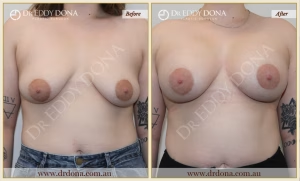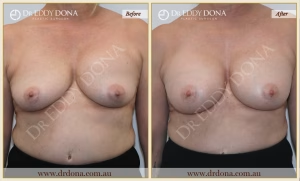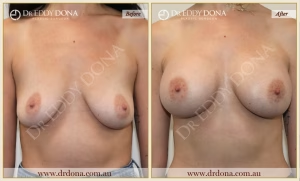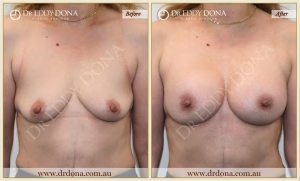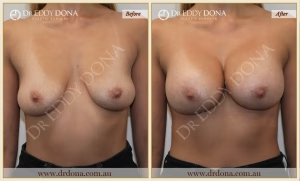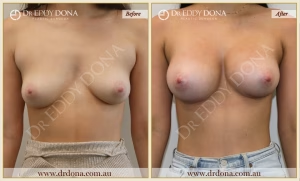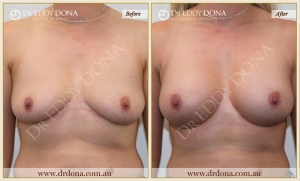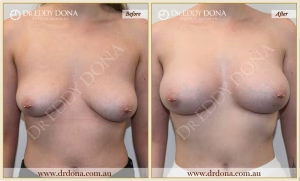Breast Surgery
As a meticulous practitioner, Dr Dona consistently refines his surgical skills, maintaining a steadfast commitment to delivering excellence in Plastic Surgery.
Book a Consultation With Dr Dona or Request a Callback

Breast Surgery
BEFORE & AFTER GALLERY
The displayed before and after pictures are provided as an educational tool to demonstrate some of the results achievable from plastic surgery. Results may vary due to many factors including an individual’s genetics and lifestyle. All surgery carries risks and requires recovery time.
Breast Surgery SYDNEY
Breast Implant surgery (aka Bilateral Augmentation Mammoplasty or BAM) is a plastic surgery procedure performed to increase breast size. Typically, silicone implants are inserted to enhance the volume and shape of the breasts. Breast Augmentation surgery is performed for cosmetic reasons or to rebuild the breast after recovering from certain conditions, such as breast cancer. Breast Implant surgery is the most common cosmetic surgery procedure in Australia and across the globe.
When considering Breast Augmentation (Breast Implant surgery), it’s vital you consider your options and do your research carefully. Not all surgeons are equal — or have the same level of expertise and experience. Dr Eddy Dona is a highly experienced specialist plastic surgeon who has dedicated much of his profession to Breast Implant surgery.
Women seek Breast Augmentation to:
- Enlarge smaller breasts
- Improve asymmetrical breasts
- Increase projection and fullness of breasts
- Reconstruct breasts after mastectomy or injury
- Enhance breast volume and shape after pregnancy, weight loss or breastfeeding
BOOK A CONSULTATION

Call 1300 373 662
- OR -
FREQUENTLY ASKED
QUESTIONS
Learn more about Breast Augmentation SurgeryThe commonest complaint by patients after augmentation is “I wish I was bigger”!
The reasons for this are many:
- Some surgeons are reluctant to use fuller sized implants as they lack the confidence to do so.
- Many patients are reluctant to use fuller implants as they are simply scared to do so.
- However, the main reasons relate to how things change during the early stages after surgery. The two issues here are:
- The initial swelling that many patients tend to like slowly goes away.
- At the same time the patient gets used to (and likes) the larger breasts. So once the swelling has settled, this is when they realise – “I wish I was bigger”.
Human nature means that any change creates anxiety – therefore to minimize the anxiety people minimize the degree of change.
With respect to implants, that means you minimize the size of the implants.
Listen to your skilled and experienced plastic surgeon. Don’t go to your consult with a “volume” that you want in mind.
IMPLANT EXPIRATION DATE – one of the common myths about breast implants is that they need to changed every 10 years. This is definitely NOT TRUE. As long as your implants/breasts continue to look and feel good, nothing needs to change. So potentially they could last a lifetime.
However, your body will continue to change over time implants or not – time, gravity, weight fluctuations, pregnancy, breast feeding, lifestyle, genetics etc… things will change. So, for these reasons, you may want to have further surgery at some later date.
Also, large breasted women, whether they are natural or implants, gravity is far less kind to them than smaller breasted women. So, it’s really important to always wear good supportive bras all the time, except for those odd occasions that warrant no bra. You support them as much as possible, and they’ll look after you as long as possible. However, problems can arise with implants that may warrant surgery, and these are discussed below.
The answer to this is simply NO. Silicone breast implants have been used for approximately 50 years, and extensive research has shown that it does not result in an increased risk of breast cancer. Of course, the reality is that with or without implants, a women’s lifetime risk of developing breast cancer is approximately 1 in 8. So, it’s important that you undergo normal breast cancer screening as dictated by your age and family history. Furthermore, when having mammograms or ultrasounds just inform the person doing them that you have implants.
Having implants does not reduce the ability to detect breast cancer through routine screening.
Finally, routine breast self-examination should continue monthly, and some women would say that having implants can sometimes make breast self-examination a little easier.
Do you lose chest muscle (pectoralis major muscle) strength after augmentation? The answer to this is sometimes no, and sometimes yes.
Implants placed in front of the muscle do not move when the chest/pec muscles are contracted. So basically, you can’t make your breasts move up and down with muscle activation – the term used for this is animation.
Also, implants placed on top of the muscle do not affect chest muscle function.
In contrast, when implants are placed under the muscle the breasts typically move every time you contract your chest muscles. This results in the breast implants separating and therefore the cleavage becomes quite wide whilst the muscle contracts. This occurs for all under the muscle implants. In addition to this, muscle contraction can often cause a dynamic double bubble affect, which refers to a significant indentation occurring to the underboob region every time you contract your muscle. This occurs because the pectoralis muscle remains attached to the breast tissue at this level and it pulls on it every time you contract.
An implant inserted with a modified under muscle placement such as a dual plane type 2 technique can minimize or prevent this dynamic double bubble from happening. However, this type of dual plane technique results in loss of muscle function due to the partial detachment of the muscle from the chest wall at the lower chest level. Combined with the detachment from the lower part of the breast tissue, this relatively small segment of muscle will lose functionality.
In contrast the common under muscle technique, otherwise known as a dual plane type 1, does not result in any real muscle function loss. In this situation, whilst the pec muscle is typically detached from the chest wall along the lower sternum/breast region, it still remains attached to the breast tissue so it can’t retract and atrophy. It does of course result in a greater potential for dynamic double bubble affect.
DRIVING – No driving for 1 week. After that, be guided by your body. If you feel like you are safe to drive and have enough freedom of upper body movement and strength to be driving, then you can.
RETURNING TO WORK – If your work and your job involves sitting at a desk doing light office work, then you can potentially be back at work after one week.
Anything that involves heavy lifting and significant upper body movement and straining should be avoided as much as practical for 4 weeks. Of course, life goes on and the demands of life, especially for those that have young children, are such that you will do things that ideally you shouldn’t. As long as these are kept to an absolute minimum then you should be fine.
At the four-week stage, you are generally beyond the point where your physical actions could potentially compromise your results. You are therefore free to physically ATTEMPT your normal activities. However, this does not mean you will be able to do your normal activities as you will still have some degree of discomfort and weakness. So as always be guided by your body. If you are doing something and you have discomfort or pain, pull back and work around it. Eventually you will get back to your old self.
Whenever someone is having an anaesthetic, no matter what it’s for, then things can potentially go wrong. That is why no surgery should be considered “minor”. Of course, whilst the chances of the following potential problems occurring are extremely small, you still need to know about then:
- Anaesthetic issues – which can affect heart, lungs or cause strokes
- Allergic reactions – This can be very mild to life threatening.
- Clots
- Superficial vein clots, which is a complication of the cannula or drip that’s placed in your vein
- Deep vein clots – these can potentially spread to the lung and be life threatening. We do several things during surgery and after surgery whilst you’re in hospital to minimise the risk of you developing these.
- Wound problems – such as infection and breakdown
- Bleeding – early or late
- Death – whilst the chances of this is exceeding rare, any of the previous issues can result in this devastating complication.
All these potential problems are standard for any operation, although some operations and some patients have an increased risk of developing them.
